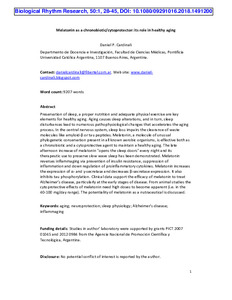Por favor, use este identificador para citar o enlazar este ítem:
https://repositorio.uca.edu.ar/handle/123456789/9738| Campo DC | Valor | Lengua/Idioma |
|---|---|---|
| dc.contributor.author | Cardinali, Daniel Pedro | es |
| dc.date.accessioned | 2020-04-17T21:58:47Z | - |
| dc.date.available | 2020-04-17T21:58:47Z | - |
| dc.date.issued | 2019 | - |
| dc.identifier.citation | Cardinali, D.P. Melatonin as a chronobiotic/cytoprotector : its role in healthy aging [en línea]. Biological Rhythm Research. 2019, 50(1). doi:10.1080/09291016.2018.1491200 Disponible en: https://repositorio.uca.edu.ar/handle/123456789/9738 | es |
| dc.identifier.issn | 0929-1016 (impreso) | - |
| dc.identifier.issn | 1744-4179 (online) | - |
| dc.identifier.uri | https://repositorio.uca.edu.ar/handle/123456789/9738 | - |
| dc.description.abstract | Abstract: Preservation of sleep, a proper nutrition and adequate physical exercise are key elements for healthy aging. Aging causes sleep alterations, and in turn, sleep disturbances lead to numerous pathophysiological changes that accelerates the aging process. In the central nervous system, sleep loss impairs the clearance of waste molecules like amyloid-β or tau peptides. Melatonin, a molecule of unusual phylogenetic conservation present in all known aerobic organisms, is effective both as a chronobiotic and a cytoprotective agent to maintain a healthy aging. The late afternoon increase of melatonin “opens the sleep doors” every night and its therapeutic use to preserve slow wave sleep has been demonstrated. Melatonin reverses inflammaging via prevention of insulin resistance, suppression of inflammation and down regulation of proinflammatory cytokines. Melatonin increases the expression of α- and γ-secretase and decreases β-secretase expression. It also inhibits tau phosphorylation. Clinical data support the efficacy of melatonin to treat Alzheimer’s disease, particularly at the early stages of disease. From animal studies the cytoprotective effects of melatonin need high doses to become apparent (i.e. in the 40–100 mg/day range). The potentiality of melatonin as a nutraceutical is discussed. | es |
| dc.format | application/pdf | es |
| dc.language.iso | eng | es |
| dc.publisher | Taylor & Francis | es |
| dc.rights | Acceso abierto | * |
| dc.rights.uri | http://creativecommons.org/licenses/by-nc-sa/4.0/ | * |
| dc.source | Biological Rhythm Research. 2019, 50(1) | es |
| dc.subject | MELATONINA | es |
| dc.subject | ENVEJECIMIENTO | es |
| dc.subject | SUEÑO | es |
| dc.subject | INFLAMACION | es |
| dc.subject | ENFERMEDAD DE ALZHEIMER | es |
| dc.title | Melatonin as a chronobiotic/cytoprotector : its role in healthy aging | es |
| dc.type | Artículo | es |
| dc.identifier.doi | 10.1080/09291016.2018.1491200 | - |
| uca.disciplina | MEDICINA | es |
| uca.issnrd | 1 | es |
| uca.affiliation | Fil: Cardinali, Daniel Pedro. Pontificia Universidad Católica Argentina. Facultad de Ciencias Médicas. Instituto de Investigaciones Biomédicas; Argentina | es |
| uca.affiliation | Fil: Cardinali, Daniel Pedro. Pontificia Universidad Católica Argentina. Facultad de Ciencias Médicas. Departamento de Docencia e Investigación; Argentina | es |
| uca.version | acceptedVersion | es |
| item.fulltext | With Fulltext | - |
| item.grantfulltext | open | - |
| item.languageiso639-1 | en | - |
| crisitem.author.dept | Consejo Nacional de Investigaciones Científicas y Técnicas | - |
| crisitem.author.dept | Instituto de Investigaciones Biomédicas - BIOMED | - |
| crisitem.author.dept | Facultad de Ciencias Médicas | - |
| crisitem.author.orcid | 0000-0002-0813-9088 | - |
| crisitem.author.parentorg | Facultad de Ciencias Médicas | - |
| crisitem.author.parentorg | Pontificia Universidad Católica Argentina | - |
| Aparece en las colecciones: | Artículos | |
Ficheros en este ítem:
| Fichero | Descripción | Tamaño | Formato | |
|---|---|---|---|---|
| melatonin-chronobiotic-cytoprotector.pdf | 374,12 kB | Adobe PDF |  Visualizar/Abrir |
Visualizaciones de página(s)
133
comprobado en 30-abr-2024
Descarga(s)
603
comprobado en 30-abr-2024
Google ScholarTM
Ver en Google Scholar
Altmetric
Altmetric
Este ítem está sujeto a una Licencia Creative Commons

